Do you know what my favourite kind of traffic is?
It’s not the hard-earned followers driven from social, or websites referring our links, it’s not even the paid traffic tests we run, so our audience knows what works and what doesn’t…
…it’s the no-cost, ever-growing kind of traffic that I adore, and it’s called Organic.
BTW: Organic traffic is the term used to describe people who visit your website via a search engine like Google.

Every single month, we acquire more organic traffic. And it’s not down to luck or money, it’s because we know what Google is looking for and we do everything we can to give it to them (by using these 35 Google ranking factors).
Priming your website and content for Search Engines is crucial. The traffic is free and if you consistently do the correct things, it’s guaranteed to grow month after month.
More traffic = More (potential) Leads, Subscribers, Followers, Customers, Reputation, Stature, Authority, Fame, Exposure, basically whatever it is you’re hoping to achieve…
…and when the traffic’s free and takes little effort, it’s so much sweeter.
Why Google?
You may have noticed that I’ve aimed the term ‘Organic Traffic’ specifically at Google, even though there are tons of other search engines.
There’s a reason for that, check out the Search Engine Market Share Worldwide:
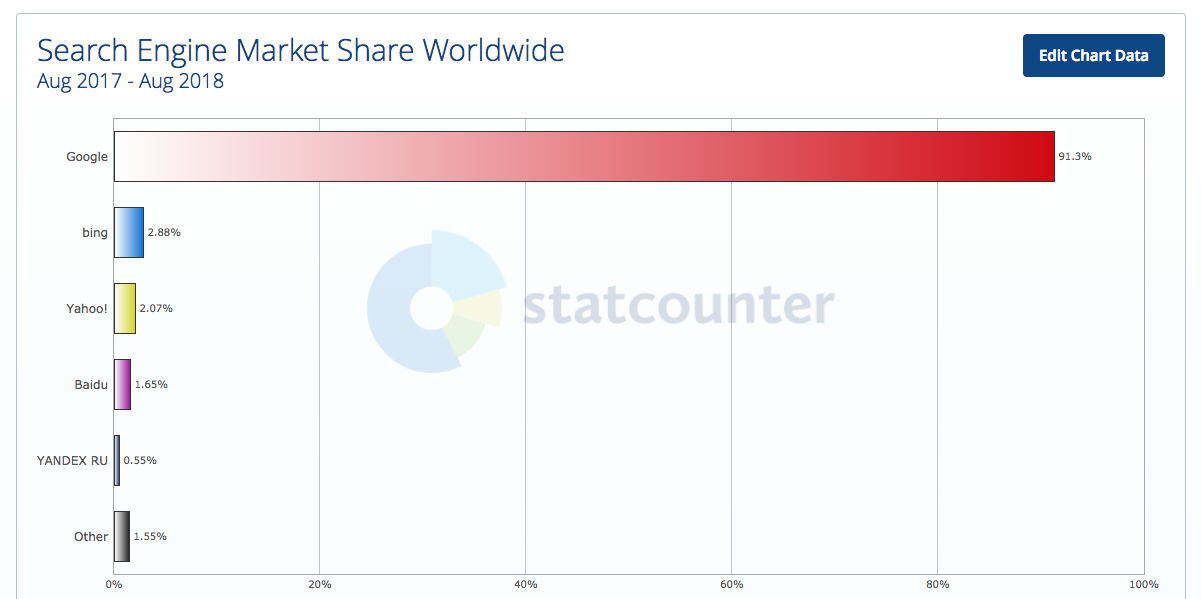
Yep, Google are so far ahead, we’d be stupid to concentrate our efforts on anybody else, especially when you consider:
- Baidu and YANDEX RU have a combined 2.2% of the market. They are primed for Chinese users and I would not consider this our target market (yet, plans for world domination coming soon).
- The other search engines use similar measurements to these Google ranking factors so, by aiming for the best, we’re actually hitting all.
- SimilarWeb estimate that Google.com (just the .com domain) receives almost 44 Billion visits per month, making it the number 1 website in the world.
Google’s Traffic
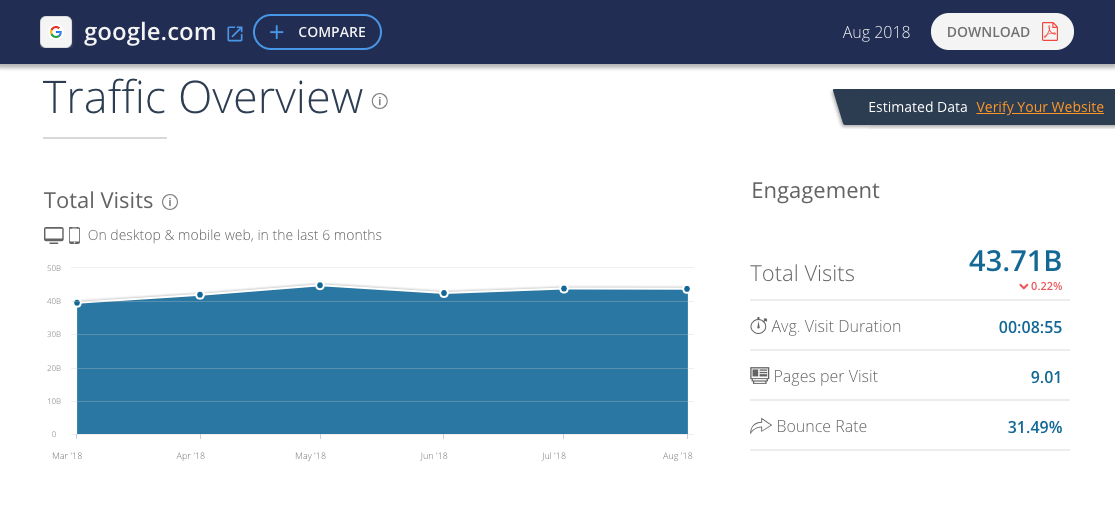
BTW: If you were able to get just 0.001% of Google’s traffic per month via organic, you’d have an extra 440,000 free visitors, not bad eh?
In fact, Google are so dominant, that not only do they own the Number 1 website in the world (based on traffic), they also own Number 2 (Youtube), Number 15 ( google.com.br), Number 17 ( google.co.in), 18, (google.co.uk), 21 (google.co.jp)…
…the list goes on and on. 15 of the world’s 50 most visited websites are Search Engines owned by Google (similarweb)…
…so, if you aren’t priming your website to attract visitors from it, you’re missing a massive opportunity.
In this post, we’re going to run through the 35 most important ranking factors on Google.
I’d suggest you keep this page handy (bookmark or favourite it), and check on it every time you update your website, but remember…
Organic traffic requires consistency.
If you follow everything in this post and keep working at it, your organic traffic will grow month after month.
The 35 Most Important Google Ranking Factors
In the name of simplicity, especially when tackling a potential trip-hazard like SEO, I’ve broken the Google ranking factors into larger categories.
If you’re new to SEO, tackle these categories and their factors in the order listed below…
…I’ve put them in this order for a reason!
Some of them will have a much greater effect than others, but the strength of your SEO will be based on the sum of these factors, not individual ones.
Important Google Ranking Factors: General SEO
Load Speed
Google cares about the speed of your website.
Make sure you’re performing regular speed checks and optimising your site.
There are loads of website speed checkers out there, I’d recommend using Pingdom or Google’s own speed testing tool.

Security
Google don’t want to put their users in danger or recommend a website that could harm their reputation.
Sites with proper protection and encryption will rank higher than those without.
Make sure your site is HTTPS ready. Learn more in our article, Don’t Get Labelled ‘Not Secure’, including how to encrypt for FREE.
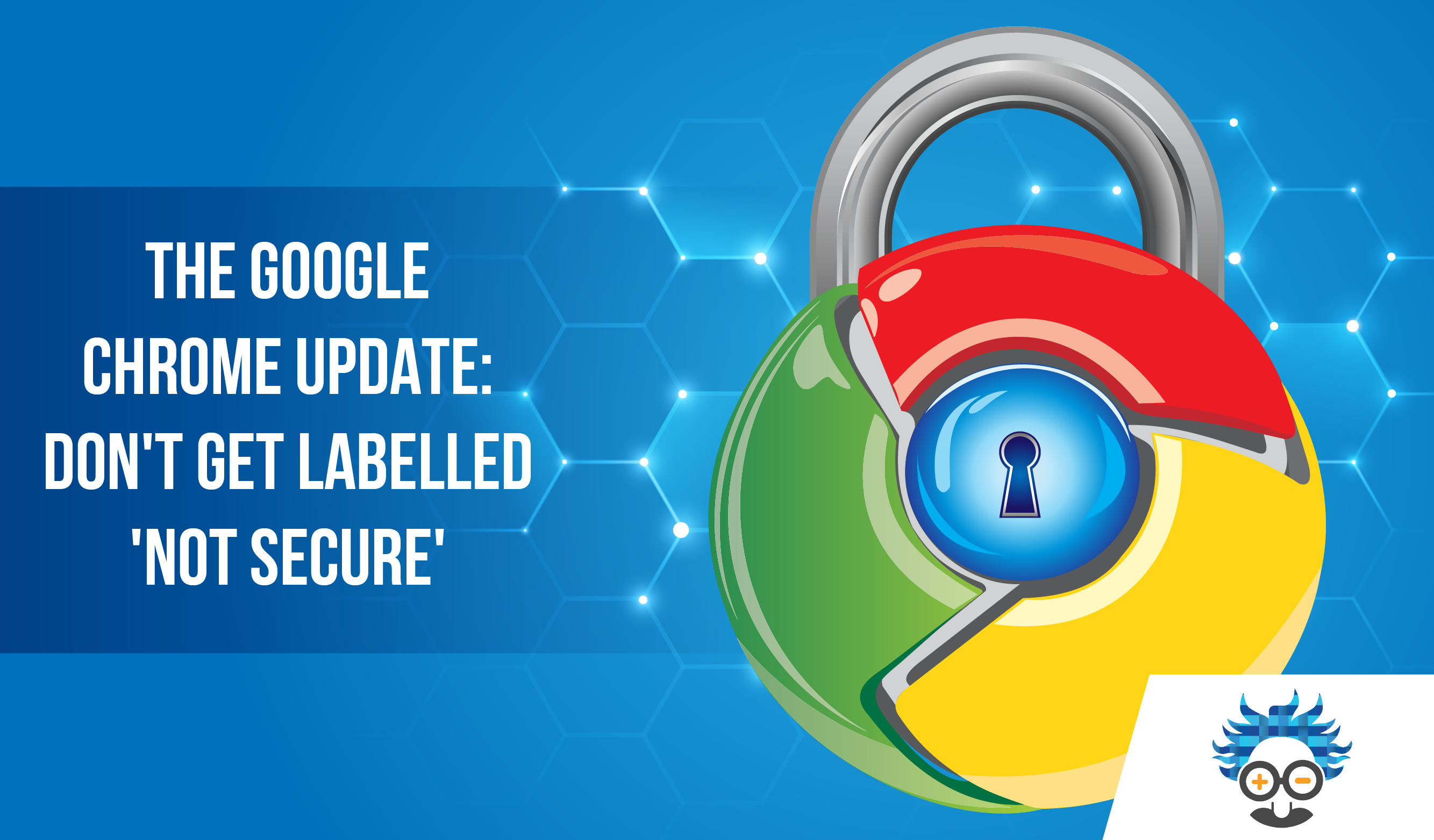
Sitemap
A sitemap helps Google to navigate and rank the importance of all the pages on your site.
If you’re using WordPress, install the Yoast plugin and set one up using that, if not try an online sitemap generator.
Install Google Search Console (previously called Webmaster Tools), to find out if you’ve already got one in place.
Mobile Friendly
51.89% of worldwide web traffic is from mobile (STATISTA).
Your site must be optimised for this increasingly popular device and there’s no surprise that Google use it as a ranking factor.
If your website’s theme or functions don’t suit mobile, you’ll be penalised on search.
Mobile Load Speed
Mobile load speed is absolutely massive and continues to grow in importance.
Make sure image and video sizes are minimised to speed up performance.
Check your site’s mobile speed for FREE with testmysite.withgoogle.com.
This awesome tool runs a test, compares your website to competitors and even tells you how to improve.

AMP
Also known as Accelerated Mobile Pages. This might not affect your desktop rank, but it definitely will on mobile.
When AMP is installed, you’ll receive the lightning bolt symbol on Google results page, and your pages will load instantly.
Find out more about AMP in our comprehensive guide.
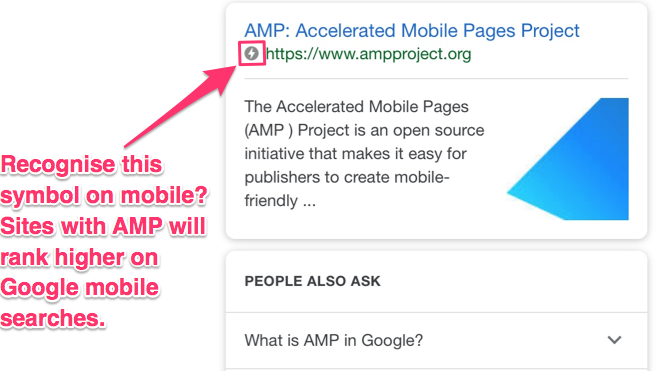
Domain Age
Older domains have a better chance of ranking than newer ones.
There’s nothing you can do when starting out – except to buy an existing domain.
Otherwise, you’ll have to do what everyone else does, and remain consistent!
Domain Authority
The greater the authority of your site, the higher you’re going to rank.
There are over 40 different signals of Domain Authority and nearly all of them are influenced by external links.
A website is ranked from 1-100, with 1 being the lowest and 100 the highest.
Check your Domain Authority with the Website Authority Checker, and improve it with our Domain Authority Guide.
Page Meta Descriptions
A meta description is the grey text that appears beneath a search result title. Every page and post needs one.
It gives Google more unique text to scroll and these descriptions should include keywords that your target audience would search for.

Schema
This is a list of microdata tags that can be added to your website so Google can understand its contents quicker and easier.
Check out schema.org to find out exactly how it can improve your ranking.
Crosslinks
Otherwise known as internal links, these are links within your website that connect pages.
Google use Internal links to check the navigational quality of your website and rank the importance of certain pages.
If you’d like a particular page to rank well on Google, make sure you use plenty of crosslinks to show Google its importance.

Regularity/Recentness
Regular activity on your site is a sure-fire way of showing Google that you’re active.
Consistently updating your site with fresh content guarantees to push you up the rankings.
Quality Signals
These include spelling and grammar mistakes, as well as navigation.
What Google doesn’t discover using their AI, they understand from user behaviour (more on this soon!)
Important Google Ranking Factors: Content
Keyword Density
This used to be a key indicator for Google, but not anymore.
Google realised that web owners and SEO marketers were packing content with keywords in a desperate attempt to rank.
Sadly, content that’s stuffed with keywords tends to lack quality and Google have recognised this.
If you pack your content with keywords now, Google will penalise you.
Yoast encourage people to go for a keyword density of 0.5-2.5%.
Headline
Search terms (aka keywords) included in headlines and page titles will rank better than those without. E.g. this page will rank better for the search query, ‘Important Google Ranking Factors’, than ‘search engine results order’

Sub-headings
Using sub-heads will help you rank for multiple reasons. They break up your page, making it easier for visitors to read (Google really care about UX).
Sub-heads improve page navigation and can include keywords.
Make sure you’re using relevant H2’s, H3’s and H4’s in your content.
Writing these as questions will also put you in a strong position for voice search.
Table of Contents
A table of contents (like the one at the top of this page) is another way of showing Google just how easy it is to navigate your page.
The content buttons are effectively internal page links, which also helps ranking and relevance scores.

Content Length
The length of your written content will make a significant contribution to your ranking, particularly if you’re blogging or content marketing.
As a general rule of thumb, the more content on a page, the better you’ll rank, particularly for user behaviour like dwell time.
Keyword Position in Headlines
Although this won’t instantly propel your content to position one, moving your content’s keyword to the start of the article has been thought to help it rank higher.
Slug or URL extension
This is everything that comes after the / in a page’s URL. For example in www.einsteinmarketer.com/google-ranking-factors, ‘google-ranking-factors’ is the slug.
Make sure you shorten your slug so it’s user friendly, and directs Google to the specified keyword you’d like to rank for. Separate your words with a hyphen ‘-‘.
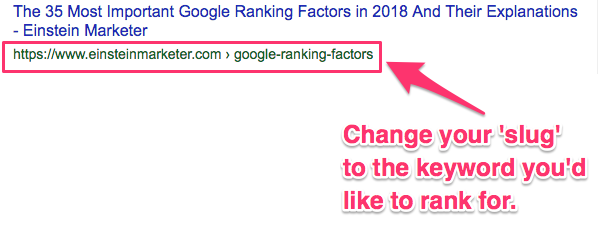
Subdomain
Instead of using ‘slug’s’ or URL extensions, some websites choose to use subdomains. These are particularly relevant to sites who are publishing content that isn’t completely relevant to their regular domain site.
For example, instead of having the blog at www.einsteinmarketer.com/blog, a subdomain would be blog.einsteinmarketer.com. The keyword comes before the domain name.
Content Meta Description
Every piece of content you publish must have a meta description and it should always include the keyword you’d like to rank for.
Google regularly change the character limits of their meta description, so make sure you’re up to date.
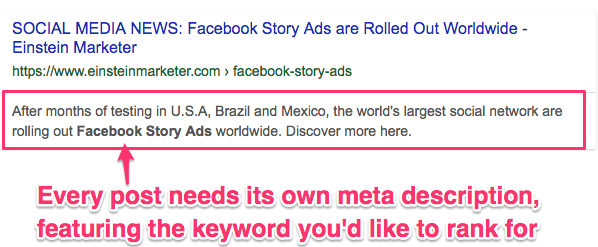
Variety of Content
Video is taking over and Google know it.
Content that includes video is likely to rank a lot better, especially as engagement and social shares are generally higher for this content type.
A blend of audio, images, written and video will appeal to more people, hold visitors on your page for longer and ultimately help you rank higher.
Alt Text Tags
An alt-tag acts as an anchor for an image.
Every image uploaded on your site must have one!
Use relevant images and relevant alt-text keywords as a result.
Learn more about Image SEO tactics.
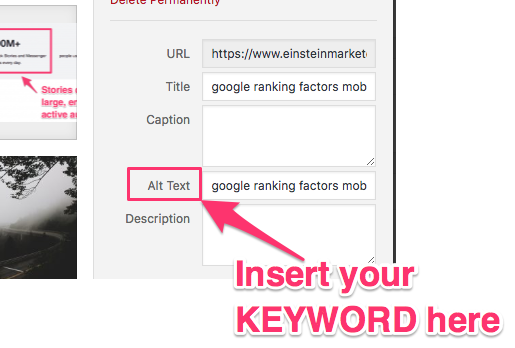
Solid Links
Google might claim that they don’t rank sites on the number of embedded external or outbound links, but they will penalise you if you link to sites that Google deem untrustworthy or dangerous, as well as links that have been deleted.
Make sure you stay on top of broken links to old pages. Use a free tool like BrokenLinkCheck to stay ahead.
Bullet Points and Numbered Lists
Google loves anything that makes a page easy for their AI to read, clearly solves an issue and simplifies things for their users.
Bullet points and numbered lists are a great way of doing this.
If Google really likes your list, they might even use it in the much sought after ‘position zero’, recipes are a great example
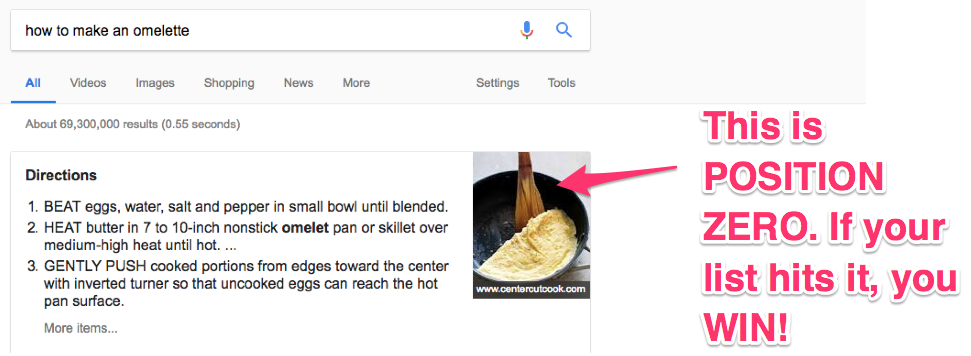
Important Google Ranking Factors: User Behaviour
All of these metrics can be tracked by Google Analytics.
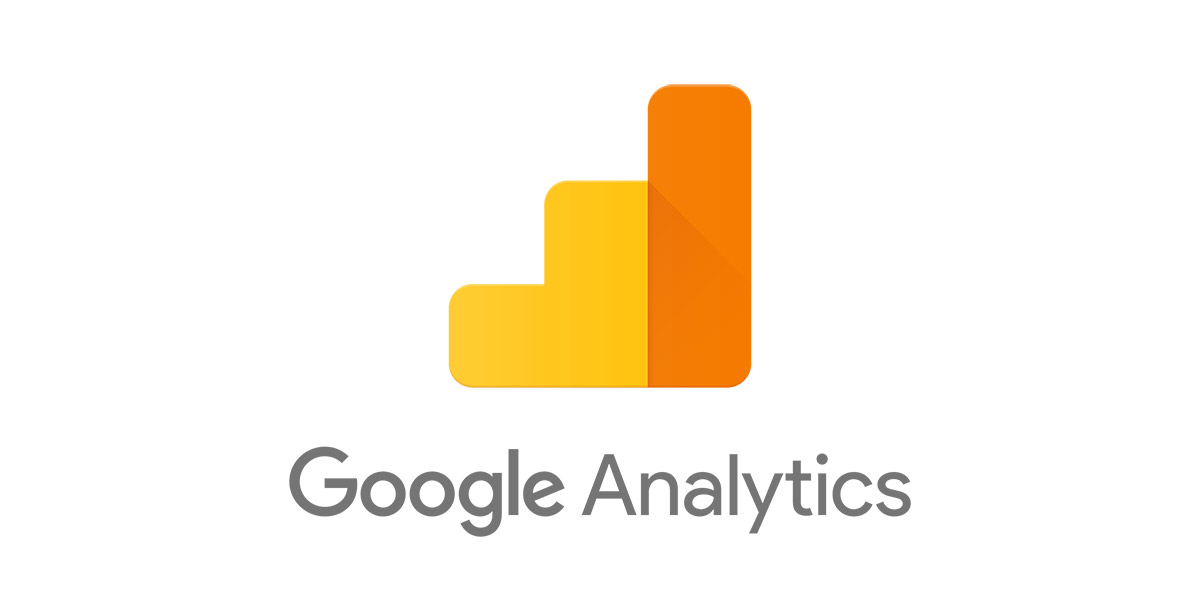
Bounce rate
SEO marketers have been debating bounce rate and its link to search engine ranking for some time, but last year SEMRUSH pretty much put an end to that discussion.
Their article about Google ranking factors puts Bounce Rate as one of the most important in Google’s search algorithm.
The lesson here, make sure every page has a goal, and you (at least try to) drive traffic somewhere.
Time on Site
Google’s recent algorithm updates have all been based around user experience and the longer a visitor spends on your site, the greater indication that your site has quality content.
Including a video in your content is a great way of boosting these numbers.
Pages per Session
this is the number of pages a visitor views before exiting your website. The higher the number, combined with time on site stats, the greater the indication of quality.
Direct Website Visits
Having a loyal list of visitors who come to your site directly proves that your site has high-quality content.
Google use this as a strong ranking signal.
Google Ranking Factors: Off-Site Strategies
Social signals
Whilst social media alone will not help your page rank, it can show Google that your site is well liked and provides users with something of value.
Shares, likes, comments and followers can all make a difference to your ranking.
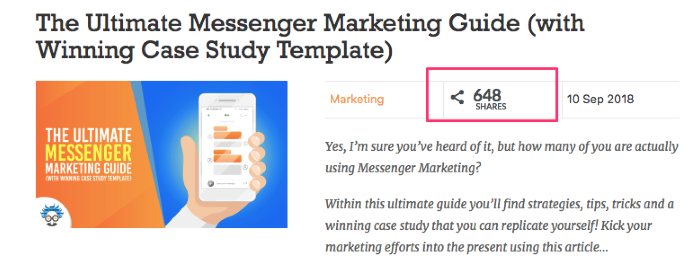
Business Listing (inc. contact)
Listing your business’ opening hours, location and contact information shows transparency and trust.
It’s also more information for Google to display to their users.
Backlinks
A backlink is a link to your website, page or content from an external site.
They are one of the most important Google ranking factors, especially for performance, domain authority and referral traffic.
If you aren’t already, try to build relationships with other relevant websites. This will give you a continued opportunity to receive backlinks for content.
Use SEO Review Tools Free Backlink Checker to keep a track on yours.

Domain Authority of Backlinks
As mentioned earlier, Domain Authority is a crucial indicator for Google.
If your backlinks are all from sites with relatively low Domain Authority, it’s likely that they’ll have no effect. But, if you’re able to get backlinks from websites with high Domain Authority, it will show Google that website with high value, value you.
This will significantly improve your ranking chances.
Click-Through-Rate (CTR)
This is the percentage of people who click your link when they see it on Google’s results page.
If Google are showing your page to lots of their users (impressions), and none of those people are clicking it, it shows Google that their audience don’t value this content.
The higher your CTR, the higher your rank.
Check this on Google Search Console (if you’ve signed up for Google Analytics, it will use the same login).
If you’d like to learn how to improve your Google CTR check out our blog, Google Search Console: the Secret to More Organic Traffic.
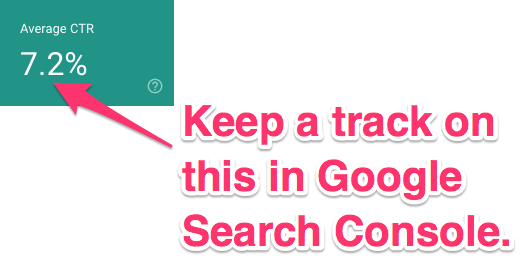
Conclusion
So, those are the most important Google Ranking factors and their explanations.
Hopefully you’ve found some takeaways, discovered something new about Search Ranking and are readily enthused with energy to rise up Google’s rankings…
…but, we’re not done yet.
That’s right, Google have loads more ranking factors than just the 35 included in this article. I’ll be updating this article regularly, with new factors that could make all the difference to your site’s performance.
Want more marketing guides, strategies and tactics? Check out one of our most popular ever digital marketing articles:
- Priming in Marketing: Advertising Psychology 101
- Instagram Post Reach: 9 Tactics to Reach More People on Insta
- Facebook Page Likes: How to Get 1000s of Page Likes!
- Author Details





26 Responses
Great article! Thanks
Thank you Sanju!
Josh,
Great job putting together a comprehensive list with concise explanations. An easy read, but packed with accurate info. Well done. I wasn’t aware that direct visits was a ranking factor. Thanks for educating me on something new.
Thanks John! Glad you enjoyed it!
Thank you for this post… Really appreciate your writing skills. What an informative and needful post indeed.
Wow, awesome website layout! How long have you been blogging for?
you made blogging look easy. The overall look of your site is wonderful, let alone the content!
Hi Josh, That’s a really nice article. SEO is a forever changing industry and keeping an eye on every small tip is important. These tips will greatly help to get more traffic to websites. Keep sharing such posts.
Hey Kevin,
Thanks for the comment! Pleased to hear that you enjoyed the article! SEO is a tough nut to crack, but as long as you keep putting quality into your content, Google will keep rewarding you! As their algorithms get smarter, they’re able to penalise more and more people who are trying to take shortcuts to get to the top. Aim for the long-term and you’ll succeed!
i search here all factor about ranking that i was mistaken, so after read your blog post ,i really feel that am a SEO master for my post, so thanks for share that sort of information
Thanks Zor, pleasure to help you out!
I was just browsing on internet accidentally, I came across your article, When I read it i find it very useful you have covered almost everything. Anyway Thank you so much it is worth sharing
Nice post. A huge list full of information.
you are sharing a precious piece of information.
Thank you, glad you enjoyed it!
good work keep it up
very important for SEO, thanks for this guide Josh
Thank you Leonard!
I’m so happy to read this. This is the kind of manual that needs to be given at other blogs. Appreciate your sharing this great content. I’ll try to use all 35!
Good luck Porter!
It is very rare these days to find sites that provide info someone is looking for. I am glad to see that your website share valued info that can help to many readers!
A comprehensive set of Google ranking factors. Thank you!
Thanks Charlae!
thanks for this wonderful post
A comprehensive set of Google ranking factors. Thank you!
Nice post